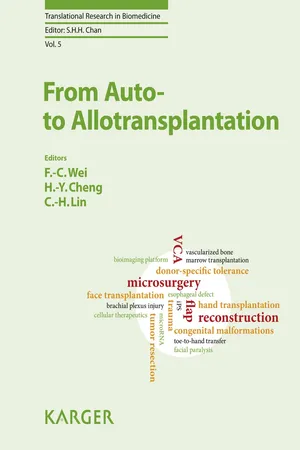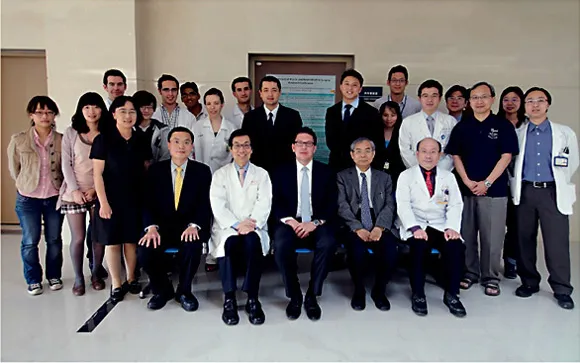![]()
Section III: Basic and Translational VCA Research at Chang Gung
Wei F-C, Cheng H-Y, Lin C-H (eds): From Auto- to Allotransplantation.
Transl Res Biomed. Basel, Karger, 2016, vol 5, pp 103-111 (DOI: 10.1159/000444970)
______________________
Establishing a Center for Vascularized Composite Allotransplantation: The Experience of Chang Gung Memorial Hospital
Hui-Yun Chenga · Nidal F. Al Deekb · Fu-Chan Weia-c
aCenter for Vascularized Composite Allotransplantation and bDepartment of Plastic and Reconstructive Surgery, Chang Gung Memorial Hospital, and cCollege of Medicine, Chang Gung University, Taoyuan, Taiwan, ROC
______________________
Abstract
Vascularized composite allotransplantation (VCA) has demonstrated promising results and potential, expanding possibilities for defects not amenable to reconstruction by means of autologous tissue transplantation. Success in VCA relies on multidisciplinary efforts derived from different specialties such as immunology, surgery, rehabilitation, psychology, etc. Setting up a platform to integrate these professions is thus critical for successful and innovative clinical practice and in-depth basic research. In this chapter, the authors’ experience in the establishment and development of a modern VCA center at Chang Gung Memorial Hospital, Taiwan, and in pioneering a successful clinical VCA - the first in Taiwan - is presented. The short- and long-term goals of the Chang Gung Memorial Hospital VCA Center, along with potential challenges and possible solutions, are also discussed. This chapter indeed provides invaluable lessons for those who are interested in pursuing and contributing to allotransplantation.
© 2016 S. Karger AG, Basel
Reconstructive microsurgery has reached its epitome. However, there are still conditions not amenable to autologous reconstruction. Animal bites, ballistic injuries, tumor extirpation defects, and congenital deformities can be extensive to the degree that autologous tissue is inadequate/deficient to replace like with like.
These formidable defects can now be reconstructed using allotransplantation techniques. Since the first successful hand allotransplantation in France in 1989, almost 200 vascularized composite allotransplantations (VCAs) have been performed worldwide with a good success rate, reflecting an expanding indication and increasing efficiency. Although acute rejection, long-term immunosuppression and subsequent related complications, and the risk of chronic rejection are the most common concerns associated with the procedure, when carefully planned and executed, the outcomes are astonishing both functionally and aesthetically.
As life is now more sophisticated than ever, quality of life and restoration of dignity are of utmost importance. Allotransplantation is the only technique available today that restores human dignity to those once deemed unreconstructable. Therefore, the significance of reconstructive allotransplantation surgery needs no further emphasis.
However, what brought the success about could be more important than the success itself. No successful allotransplantation has ever been possible without a multidisciplinary approach exploiting the work of a committed team of scientists, surgeons, physicians, nurses, physiotherapists, etc. Moreover, it has never been possible without adequate research and cadaveric surgery preparation and profound experience in clinical microsurgery.
For proper and purposeful assembly of teams, an operation platform is needed, and the development of a comprehensive center for vascularized composite allotransplantation becomes essential. The focus of this chapter is on the establishment and development of a modern VCA center at Chang Gung Memorial Hospital, featuring the foundation, team development, short- and long-term goals, and encountered challenges and how to overcome them, which shall provide insights on what it really takes to walk the path of allotransplantation in Taiwan.
Foundation and Team Development
The inspiring vascularized composite allotransplantations performed in France and Austria touched the heart and mind of Fu-Chan Wei, the founder of Chang Gung Microsurgery Center. A long time ago, he foresaw the potential of VCA in reconstructive surgery, but the conservative Taiwanese culture and the life-long immunosuppression associated with allotransplantation were strong concerns to him. Nevertheless, and in the wake of successful clinical VCA in Europe, he started to push harder than before in the direction of VCA, supported by ambitious, like-minded surgeons from Chang Gung Memorial Hospital as early as 2000.
Since VCA is not a routine microsurgery procedure, and given the concerns mentioned, strategic planning was needed, which turned out to be thoughtful and rewarding. After its establishment, the core team started to educate and familiarize the young staff, residents and fellows, and researchers with VCA and its potential, advocating commitment and adequate preparation once the VCA program officially received its go-ahead to start.
After that, fellows experienced/interested in VCA were recruited and given full support, financially and logistically, and assigned to work along with the members of the team. The goals of this step were first to train and motivate the junior members of the team, second to create an interactive brain-storming environment that is even more inspiring, and three to develop animal models essential to immunological studies and immunosuppression protocol development with low mortality and morbidity. The outcome was rewarding for all. Rat models of heterotopic hind-limb and ear VCA were established [1, 2], and ample anatomic knowledge of the rat as a model for allotransplantation and also from cadavers regarding clinical VCA became available [3] (fig. 1). The participating international fellows fulfilled their passion and further pursued it in their countries, maintaining good collaboration with the Chang Gung team, developing new protocols to induce donor-specific tolerance [4, 5], and expanding the application of the animal models [6, 7].
Fig. 1. Various VCA models in rats (a, b), a minipig (c) (reproduced with permission from Elsevier [11]), and a mouse (d).
The next phase was to identify potential spearheads in VCA among young faculty staff at Chang Gung Memorial Hospital, and then to further cultivate them in VCA science and techniques by sending them abroad to leading centers in the USA for 1-2 years.
Three young surgeons were selected. Dr. Wei-Chao Huang was sent to the University of Kentucky at Louisville where he learned from Dr. Suzanne Ildstad. He developed an osteomyocutaneous VCA model in rats and focused his interest on the role of microchimerism in induction of donor-specific tolerance [8, 9]. Dr. Yur-Ren Kuo was the second, and he was sent to the University of Pittsburgh to learn from Dr. Andrew Lee and his team. Upon his return, Dr. Kuo developed facial and hind-limb VCA models in miniature pigs [10, 11]. His work was significant for preclinical evaluation of immunosuppression protocols in mammals and for preclinical allotransplantation rehearsal. Dr. Cheng-Hung Lin was the third, and he also was sent to the University of Pittsburgh as well as Johns Hopkins University to learn from Dr. Andrew Lee and his team. Dr. Lin's contribution was the mice osteomyocutaneous VCA model that benefits from mouse genetics to facilitate studying the mechanisms of rejection/donor-specific tolerance induction in depth [12] and the mystacial pad VCA model in rats and mice for functional assessment after face VCA in rodents. The combined work of Lin, Huang, and Kuo under Wei's leadership has truly reshaped and redefined the path of VCA at Chang Gung Memorial Hospital. It has opened the door for a new level in related translational research and clinical VCA.
Fig. 2. In vivo bioluminescence imaging for cell-tracking of Treg (PID1 = POD11). p = Photons; sr = steradian.
With the establishment of reliable animal models and cultivation of competent allotransplant surgeons who had a good appreciation and understanding of the role of immunosuppression in VCA, expansion became the next step. The Center moved towards recruiting two basic scientists in immunology and molecular biology whose role is invaluable in designing new regimens, highlighting the drawbacks and complications of one regimen over another, and providing hints for clinically applicable and safe protocols, thus empowering the potential of translational application.
The presence of outstanding scientists and knowledgeable surgeons further allowed high-level collaboration with physicians involved in other types of allotransplantation such as kidney and liver allotransplantations at Chang Gung Memorial Hospital. Such collaboration via lab work, meetings, seminars, and lectures cultivated the right environment for exchanging ideas and experience, and thus shortening the learning curve and reducing the time of exploring with trial and error.
The Center then recognized the importance of and need for noninvasive investigation modalities to assess the functional recovery after VCA, study the rejection over longer period of time, document donor cell engraftment, and provide insights on VCA from a cellular level. To fulfill that goal, the Center recruited another researcher specialized in imaging studies and acquired various high-tech imaging machines including microscopes and in vivo imaging systems equipped with fluorescence or bioluminescence-based technologies. Incorporating this with ultrasonography and MRI available on campus, researchers at the Chang Gung VCA Center were now able to probe into and visualize the processes at different levels, such as cellular trafficking (fig. 2) and fate, blood vessel pathology, and brain regional function. This strategy that Dr. Wei and his core team laid down in 2000 ultimately led to the official establishment of a modern center for VCA in 2011. This achievement reflected 11 years of evolution and hard work featuring a wide-array of interests in immunology, imaging, animal models, functional recovery, immunosuppression regimens, and donor-specific tolerance induction and maintenance (fig. 3).
Fig. 3. Professor Gerald Brandacher (center) of Johns Hopkins University and Professor Po-Huang Lee (2nd from right, front row) of National Taiwan University Hospital served as annual reviewers to the VCA Center, 2012.
Mock Surgery: Preparation for Clinical Vascularized Composite Allotransplantation
Although the surgical prowess of the Chang Gung VCA team surgeons are exceptional, allotransplantation surger...



